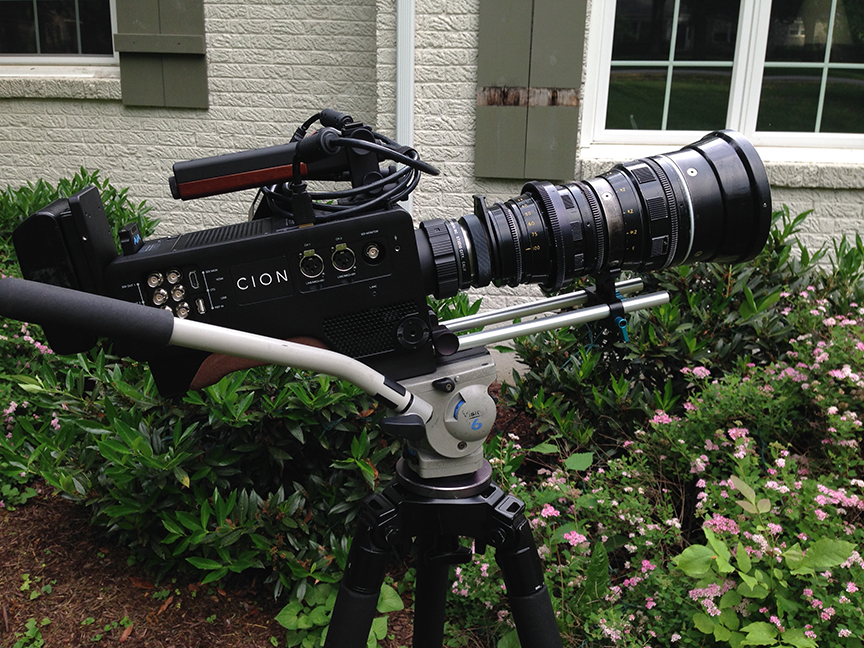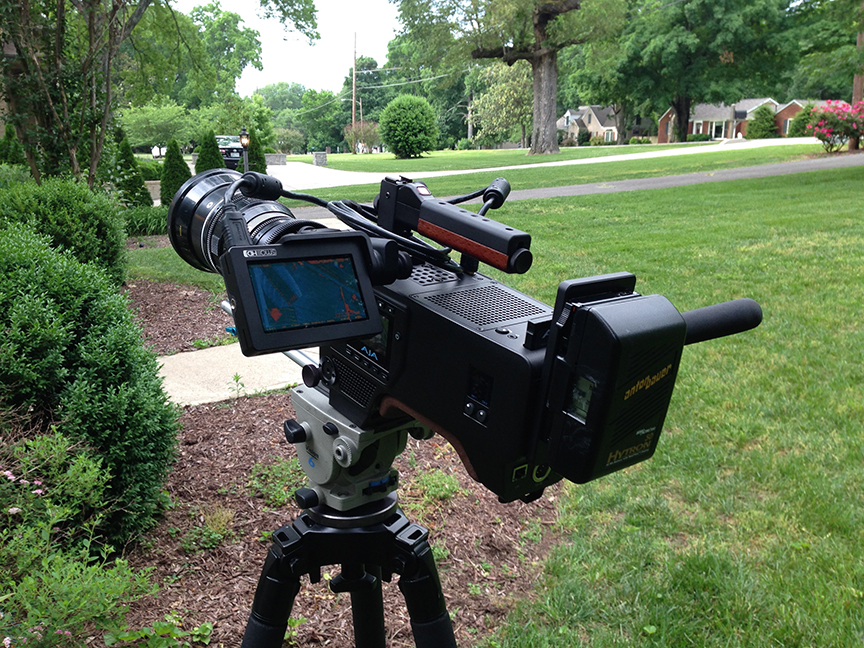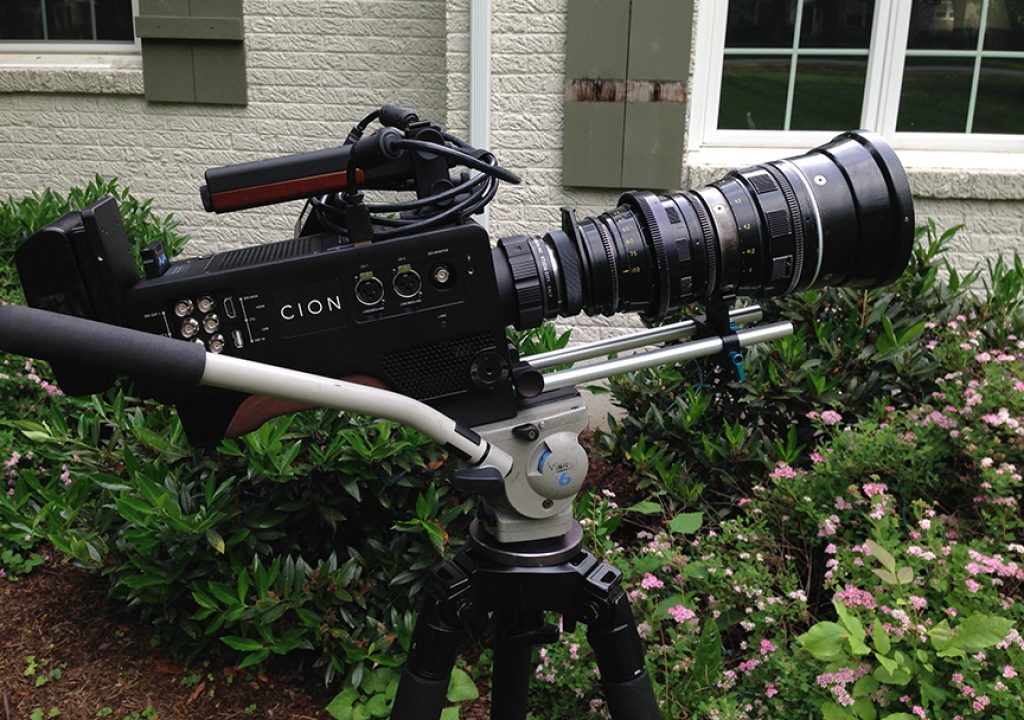Seven days was all the time I had with AJA’s Cion, and the results shuffled all my preconceived notions of the camera.
Seven days was all the time I had with AJA’s Cion, and the results shuffled all my preconceived notions of the camera.
AJA Cion “Backyard” Video Example from Brian Hallett on Vimeo.
 I’m going to be honest with you from the start: I didn’t want to like this camera. When it was first announced at NAB 2014 it had promise. It had cameramen/women wondering, and possibly hoping, for something special. Then videos were released, price points announced, and attitudes changed. The AJA Cion became the popular camera to ridicule. I am, however, not here to ridicule a camera. Especially a camera from a company who cut $4,000 from the original price, even if only for the summer.
I’m going to be honest with you from the start: I didn’t want to like this camera. When it was first announced at NAB 2014 it had promise. It had cameramen/women wondering, and possibly hoping, for something special. Then videos were released, price points announced, and attitudes changed. The AJA Cion became the popular camera to ridicule. I am, however, not here to ridicule a camera. Especially a camera from a company who cut $4,000 from the original price, even if only for the summer.
From the moment it was announced, the AJA Cion was a camera conflicted. A budget camera, but with a PL lens mount. A middle market camera, with the need to buy expensive proprietary media. A system boosting elegant controls and a menu system that feels far less elegant.
Then the AJA Cion does so much right. Both a SDI and HDMI output for an EVF. A camera just as easy to use handheld as it is on a tripod without weighting too much. Beefing recording codecs like ProRes 444 with 12 bit color and true 4K resolution of 4096×2160 instead of UHD 3840×2160. Yet, we are in a 15 stop dynamic range world featuring higher, and higher ISOs. As you can understand, the AJA Cion became a camera without a market.
MAXIMIZE YOUR SHOOT, MINIMIZE YOUR POST became the marketing message. With the AJA Cion, you no longer needed 3D LUTs or long color correction sessions. The essence being, you see what you get. So I decided to try it. No post color correction for this 1080HD run & gun style shoot.
Dark skin tones under a gas station awning quickly shows a camera’s weakness. The Cion’s 12 stops of dynamic range shows for better or for worse and I think the Cion held its own. Run & gun shooting does this camera well. The electronic global shutter comes in handy during the whip pans and quick movement. The skin tone looks great to me for an uncontrolled shoot, and the color has potential. Next is another gas give-away shoot but on a brighter day.
AJA Cion Run & Gun Example #2 from Brian Hallett on Vimeo.
In this example, the highlights are blown out. The 12 stop dynamic range is not enough to pull the highlights and the lowlights into the scene together. The skin tone, when properly exposed, looks smooth and pleasing. I did have the time to pull the footage into DaVinci Resolve to pull more information into the whites, but there was little highlight detail to be found. The shadows had more leeway, more information, and I feel like I’d be comfortable to push the image if I had to.
There is something about an image requiring considerably less color correction. In the first video of this review, I was much more pleased. The 4K detail is great. The color and saturation has the potential to be stunning. It’d help considerably if the footage was shot at a more epic location instead of my backyard. Here is the youtube link to the 4K version of the video.
WHY A PL LENS MOUNT
 I understand AJA wanted Cion to be considered a professional camera ready for the heavy lifting of broadcast television and indie, or even, feature films. The PL lens is the best option for those scenerios. For shooters on lower budgets the PL lens mount becomes another hurtle to climb over. Suddenly, more budget will need to be spent on PL lenses meaning less for everything else. I get it. I get the reasons behind choosing a PL Lens mount: 4K resolution “needs” a 4K capable lens, “professional” cameras come with a PL lens mount, and a PL lens mount means one is using better lenses. MFT makes different lens mount options. Thankfully this opens up much needed lens options for owner/opertors of this camera.
I understand AJA wanted Cion to be considered a professional camera ready for the heavy lifting of broadcast television and indie, or even, feature films. The PL lens is the best option for those scenerios. For shooters on lower budgets the PL lens mount becomes another hurtle to climb over. Suddenly, more budget will need to be spent on PL lenses meaning less for everything else. I get it. I get the reasons behind choosing a PL Lens mount: 4K resolution “needs” a 4K capable lens, “professional” cameras come with a PL lens mount, and a PL lens mount means one is using better lenses. MFT makes different lens mount options. Thankfully this opens up much needed lens options for owner/opertors of this camera.
AJA PAK MEDIA
AJA only recently has entered camera manufacturing. To them, they already had the knowledge to be able to make fast reliable media for a 4K camera. Unfortunately, their media is slightly more expensive then a CFast 2.0 card. 256GB AJA Pak Media is $695.00 and you’ll need to purchase one card reader at $395.00. Whereas Canon’s C300 Mark II uses Cfast 2.0 which cost around $586.95 for 256GB and the reader costs around $50. While the difference in price is nowhere near the likes of Red and their SSDs it is still something to consider if buying this camera. AJA Pak Media is robust and very reliable so you might consider the extra expense worth it in the end.
THE MENU
 I am not a fan of the menu design. It is neither elegent or intuitative. I am used to seeing several menu options at once instead of scrolling through them one at a time. I will say, this is nowhere near Sony menu territory though. Thankfully, the AJA Cion has a lot fewer options. This is firmware. I see a better menu in the near future if AJA is listening to their customers. The side screen? For the menu it works. For anything else = worthless. Save the space AJA and do away with the side screen. Find a way to access the menu via simple LCD, through the EVF or a Monitor
I am not a fan of the menu design. It is neither elegent or intuitative. I am used to seeing several menu options at once instead of scrolling through them one at a time. I will say, this is nowhere near Sony menu territory though. Thankfully, the AJA Cion has a lot fewer options. This is firmware. I see a better menu in the near future if AJA is listening to their customers. The side screen? For the menu it works. For anything else = worthless. Save the space AJA and do away with the side screen. Find a way to access the menu via simple LCD, through the EVF or a Monitor
LIMITING ISOs
In 2006 ISO320 and 500 were acceptable. In this day and age they are restrictive. 800 or higher needs to be the native with the emphasis on higher. If you’re going to build a camera you want to sell often, clean image at higher ISOs are a must. Usually, us cameramen/women are working with smaller crews and smaller budgets. Help us get the shot in as many situations as possible and we will become loyal fans. One can pull up the shadow levels with the Cion quite a bit, but that’s digital film cameras. Do your tests and learn how far you can push it. I had the camera for seven days so I didn’t have time to do all the tests I’d like to usually do.
IS THIS CAMERA DEAD?
 Is this camera dead before it even got started in the market? I hold my judgment. At the price of $8995.0, it’s a possibility. $4995.00? A whole different option. How about a Cion with a different sensor? It is a complete camera system boasting great color and 4K detail made by a proven company. There are a few things I think should be looked at for the AJA Cion to succeed. 1. A more sensitive sensor. This is your backbone to a great camera. Without something special under the hood it won’t go anywhere. 2. The first design and shape work well, but after lifting and shooting with the camera it felt like the camera could be smaller and more compact. Now, I’m no camera manufacturer so I cannot speak with authority, but the AJA Cion feels like it could be 2/3 its original size. 3. Give us a true Log look. Many of us prefer to go through color grading.
Is this camera dead before it even got started in the market? I hold my judgment. At the price of $8995.0, it’s a possibility. $4995.00? A whole different option. How about a Cion with a different sensor? It is a complete camera system boasting great color and 4K detail made by a proven company. There are a few things I think should be looked at for the AJA Cion to succeed. 1. A more sensitive sensor. This is your backbone to a great camera. Without something special under the hood it won’t go anywhere. 2. The first design and shape work well, but after lifting and shooting with the camera it felt like the camera could be smaller and more compact. Now, I’m no camera manufacturer so I cannot speak with authority, but the AJA Cion feels like it could be 2/3 its original size. 3. Give us a true Log look. Many of us prefer to go through color grading.
At the beginning of this article I wrote how I didn’t want to like this camera. In the end, I rather liked the image coming off the sensor. In a controlled shoot this camera has the potential to make some stunning images. I can see many indie filmmakers or commercial DPs using the camera. Plus, there is something about seeing what you’re getting off the sensor. If your images aren’t to your liking then change the lighting. The skin tones are great and the 4K detail is more than acceptable. AJA built an outwardly well designed camera with all the outputs needed, an easy to use hand-held camera, and a build suitable on larger sets. Now, if they can bring the rest of it all around they will have made a camera we all might be clammering to use. 

Filmtools
Filmmakers go-to destination for pre-production, production & post production equipment!
Shop Now













